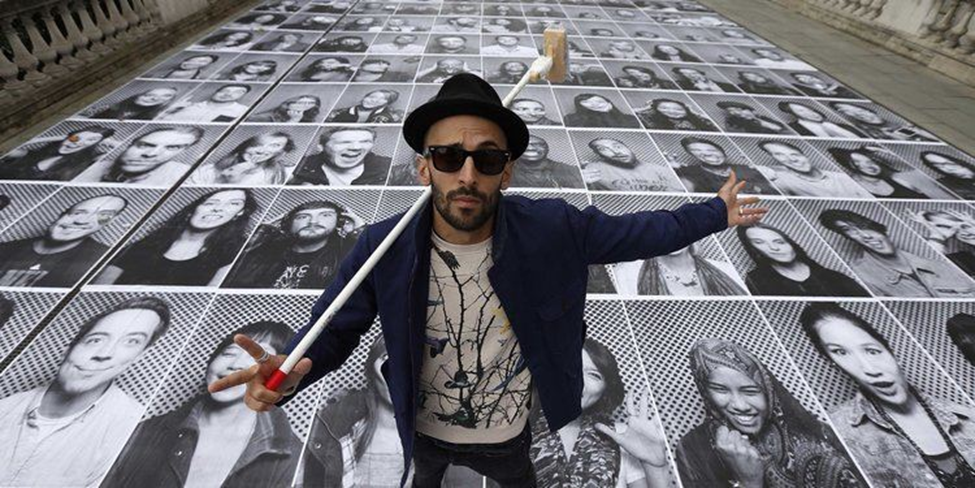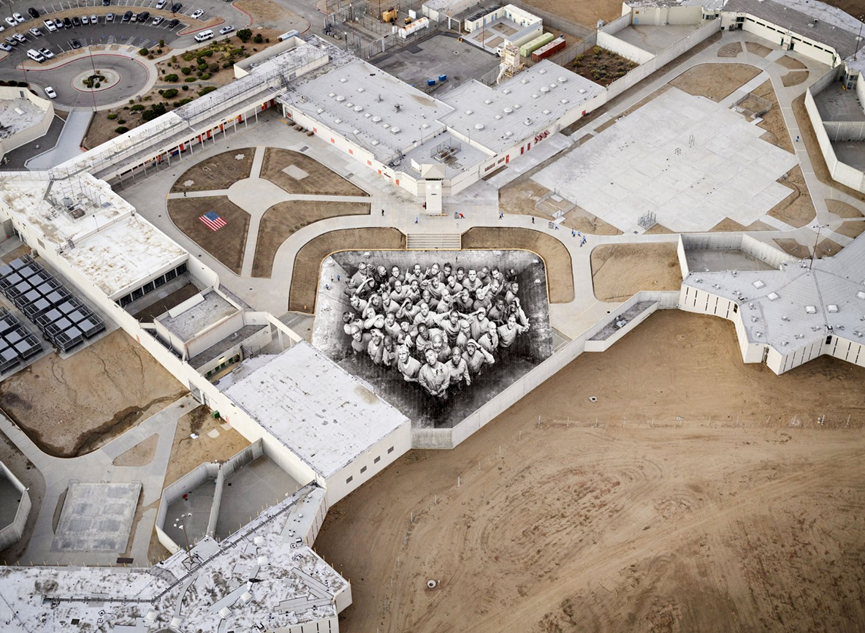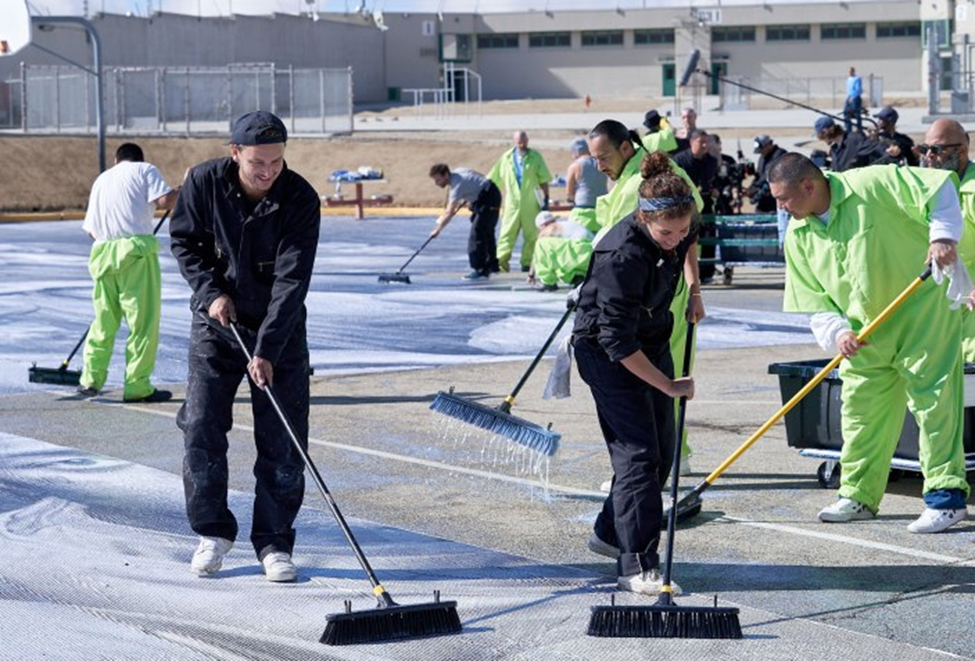On the Street: The work of JR

On the Street: The work of JR
by Betty Spackman
I am a big fan of getting both the Arts and Christianity back ‘on the street’, meaning out of the strongholds of institutions that tend to work at bringing people in (often requiring strict criteria for membership) instead of reaching out, going out, and giving. The strongholds of our belief systems and professional agendas can often lock us into a need to be right, powerful and exclusive, instead of challenging us to be truly righteous and in humility laying down our lives for others. To meet with these ‘others’, who are often not part of our normal like-minded groups, we need to step outside of the safe places we have established and risk, well, everything.
I have been part of the Christianity and Art discussions for 50 years as an artist, author and educator and I know the battle it was to convince especially the Protestant church to accept artists and include the arts in worship. That goal has partly been accomplished. Artists of faith have won their freedom. Many arts groups have started internationally, inside and outside denominational churches. However, what are we now supposed to do with that freedom? I do not believe that having art in the church and being accepted by the Christian community is the reason we are called as artists. Gathering together for mutual support is great – but is that enough?
It is helpful and affirming to have the support of our Christian community, but just as any Christian is not called just to go to church but to be in the world as light and salt, so are we as artists. And although there are as many reasons and ways to be an artist in the world and the church as there are artists, I believe we should constantly be asking, ‘What is needed today?’ Right now it is certainly not religious propaganda that is needed in a western culture that is divided by extreme evangelical right and left wing politics, as the rest of the world looks on with dismay and disgust. Scripture says it is by the love we have for one another that people will know we are Christ’s disciples (John 13:35). But right now, unfortunately, we are mostly known by our hate and divisiveness.
So, what is ‘Christian Art’? Of course this over-discussed question is always problematic but without going into that longwinded topic let me just say that, for me, an art practice that demonstrates the attitude and action of an inclusive, loving, and risk-taking vulnerability is an art that is Christ-like. However, this artwork has often come from those who do not overtly identify with any religious or academic dogmas. Therefore it is so important as Christians to look at these people with respect and learn from them. I think they are the ‘stones crying out’ (Luke 19:40). They are among the ‘singers praising the beauty of holiness sent out before the army of the Lord’ to break down the walls. (2 Chronicles 20:21). In order to be part of this powerful task we need to step outside our walls, into the streets, onto the frontlines of life.
One of the artists who for me is a strong example of this and gives real evidence that art can bring light and life to the world, is the French photographer Jean-René known as ‘JR’ (born 1983). He is an artist who literally walks the streets (as Jesus did) and who through his artmaking brings hope to communities that are often not seen or heard. Wikipedia describes him as “someone whose work combines art and action and deals with commitment, freedom, identity and limits.”
He started his art career as a graffiti artist who was not particularly interested in changing the world, but the non-conventional ways and places where he did his graffiti in public were practice for what he ended up doing as a mature artist. At 17 he started adding photographs to his graffiti work and did sidewalk exhibitions, putting portraits of people he met in Paris on the streets and roofs tops. Between 2004 and 2006 he created Portraits of a Generation, portraits of young people from the housing projects around Paris that he exhibited in huge format. In 2007 he put up large format photos of Israelis and Palestinians face to face in eight Palestinian and Israeli cities on either side of the Separation Barrier. In 2008, he did an international tour for Women Are Heroes.
In October 2010, JR won the TED Prize and used the $100,000 award money to start the Inside Out Project. The prize brought him to New York where he started another studio and worked on projects as in 2011 with members of the Lakota Native American Tribe from North Dakota.
He was included in Time magazine’s 100 Most Influential People of 2018 and has become famous for basically what are, in my opinion, good deeds and sacrificial hard work on the behalf of others. His projects are many and worth taking the time to investigate and he has gone on to make award winning films, the latest, Paper & Glue, released in 2021.
JR calls himself an “urban artivist”, he creates pervasive art that he puts up on the buildings in the Paris area projects, on the walls of the Middle East, on the broken bridges of Africa or in the favelas of Brazil. During the pasting phase community members take part in the artistic process. In Brazil, for example, children became artists for a week. In these artistic acts, no scene separates the actors from the spectators. Wikipedia

I want to point particularly to a recent project he did that moved me deeply, perhaps because I have had a small experience working with inmates in a prison in Canada. The TED TALK where he describes what happened should be an encouragement to anyone who has any doubt that art can not only bring hope to the world but can change lives. In November 2019 he worked with a group of prisoners in a maximum-security prison in Tehachapi (California) and created a photographic work on the ground of a large courtyard of that institution. The great mural, photographed from a drone, shows the portraits of prisoners and former convicts who also shared their stories as part of the project. His intention was to "give voice to prisoners" and humanize their environment. The result was that the prison and the lives of both the prisoners and the guards were changed.
Watch TED TALK about Tehachapi, The Yard: https://www.ted.com/talks/jr_why_art_is_a_tool_for_hope?fbclid=IwAR3-qHpA5kMCMd4WugJCj3OPHUQjwLs4qPj5AjwhboQOJeVngCEVS_qP3G8

*******
JR website: https://www.jr-art.net/
Betty Spackman is an installation artist and painter. She has a background in Theatre, Animation, Performance Art and Video Art, with early video work shown at ARS Electronica in Austria and Long Beach California. Her MFA thesis at York University in Toronto investigated language, territory, and the body. Her work went on, through solo and collaborative exhibitions, to explore personal and cultural exchange, the nature of ‘story’ and animal/human relations. Spackman’s last major project, A CREATURE CHRONICLE (2022), desires to provide a place of meeting for diverse cultural communities to corporately consider creation in our evolving ways of defining what it is to be human. It presents itself as a non-linear multi-layered storyboard to be walked around and sat inside, with visual stories to be ‘read’ and discovered, contemplated and discussed. Spackman believes all of life to be interconnected and that love, as both an intellectual and spiritual choice, in both story and lifestyle, is the one chance of sustainability, equity and future hope for all life. http://www.bettyspackman.com/






